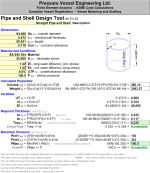PRESSURE VESSEL SHELL DESIGN CALCULATION

Description
PRESSURE VESSEL SHELL DESIGN CALCULATION
The maximum pressure a pipe or shell can withstand depends on its material properties, dimensions, and design conditions. To determine the maximum pressure, engineers typically use the Barlow's formula for thin-walled pressure vessels or the ASME Boiler and Pressure Vessel Code for thick-walled pressure vessels.
Barlow's formula for thin-walled cylinders is:
P = (2 * S * t) / D
Where: P = maximum allowable pressure (usually in psi or Pa) S = allowable stress for the material (usually in psi or Pa) t = wall thickness (in inches or meters) D = outside diameter of the pipe or shell (in inches or meters)
Please note that Barlow's formula assumes a thin-walled cylinder, which means the ratio of the wall thickness to the diameter should be less than about 1:10.
For thick-walled pressure vessels, you should refer to the ASME Boiler and Pressure Vessel Code, Section VIII, which provides more detailed calculations and design requirements.
It's essential to remember that these calculations provide the maximum allowable pressure under ideal conditions. In real-world applications, safety factors and other considerations, such as corrosion, temperature, and cyclic loading, must be taken into account when determining the maximum pressure a pipe or shell can safely handle. Always consult with an experienced engineer to ensure the safe and proper design of pressure vessels and piping systems.
Calculation Preview
Full download access to any calculation is available to users with a paid or awarded subscription (XLC Pro).
Subscriptions are free to contributors to the site, alternatively they can be purchased.
Click here for information on subscriptions.

